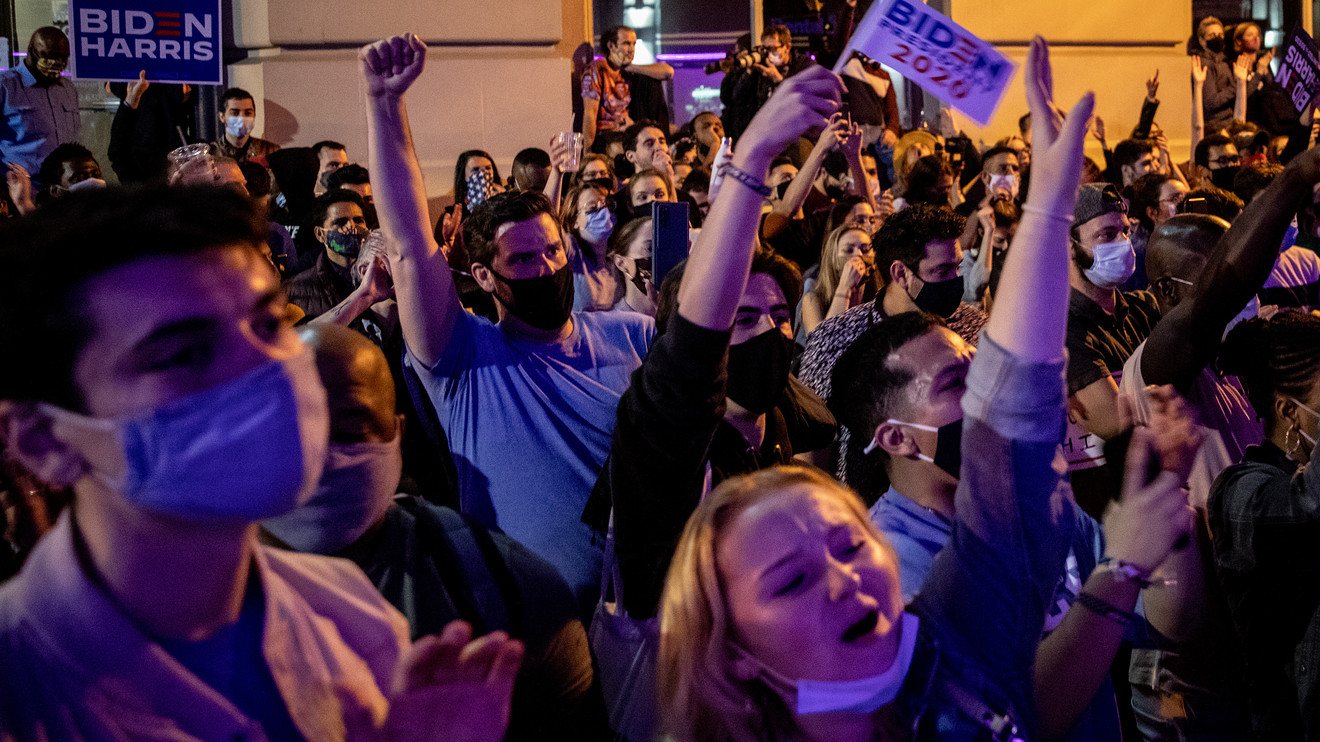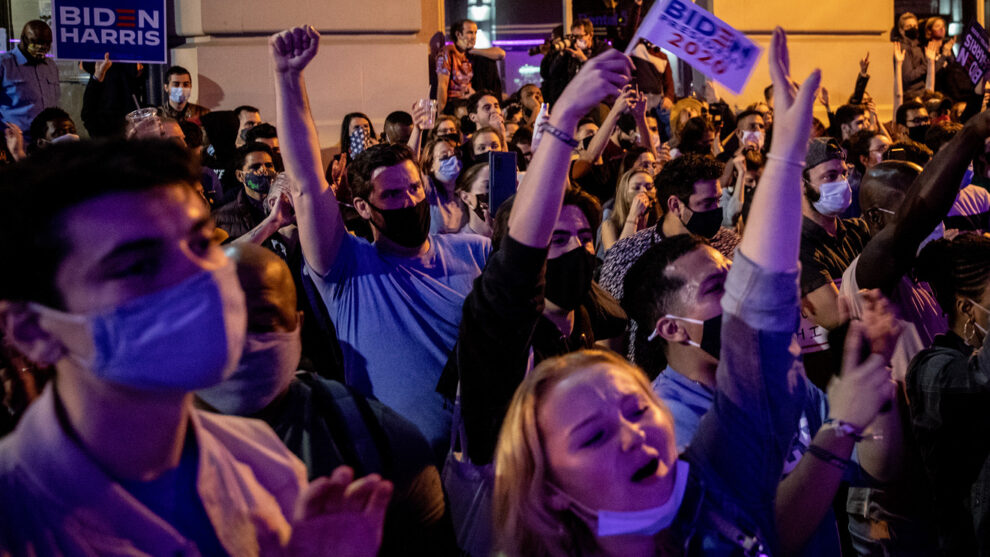
After Joe Biden was projected the winner of the 2020 presidential election by the Associated Press on Saturday, videos and images of people dancing and cheering in the streets of New York, D.C. and cities around the country began flooding social media.
Dr. Leana Wen, an emergency physician and public health professor at George Washington University who previously served as Baltimore’s health commissioner, told MarketWatch that she was “extremely concerned” while watching these celebrations being broadcast on the news and across Facebook FB, -4.99%, TikTok and Twitter TWTR, +0.16% over the weekend.
Why? Because this weekend saw more than 120,000 new cases of COVID-19 a day in the U.S. And the CDC has warned throughout the pandemic that large gatherings of people, where it is hard to keep six feet apart, can spread the coronavirus. “The more people an individual interacts with at a gathering and the longer that interaction lasts, the higher the potential risk of becoming infected with COVID-19 and COVID-19 spreading,” the CDC writes in its guidelines for events and gatherings.
“The last thing that should be happening in the middle of a pandemic, especially a raging pandemic like this, is large gatherings of people,” said Wen. “I worry about the number of infections that could result due to these gatherings over the last week.” And she suggested that those who attended these events should considering quarantining for 14 days and getting tested for COVID-19.
After all, while stocks and spirits rose Monday after BioNTech BNTX, +13.91% and Pfizer PFE, +7.69% reported that their COVID-19 vaccine candidate is 90% effective, which is a much higher benchmark than anticipated, the country is still grappling with a deadly pandemic that has spiraled out of control. The U.S. case tally also topped 10 million on Monday, and the country is approaching 240,000 deaths.
COVID-19 is thought to be spread mostly by respiratory droplets when people talk, cough or sneeze — as well as when they chant, sing and yell at celebrations or rallies. “This is a virus that doesn’t care why it is that we’re gathering. It doesn’t care if we are protesting, or celebrating, or meeting for a birthday party. It doesn’t care,” Wen said.
“ “I worry about the number of infections that could result due to these gatherings over the last week.” ”
Her words were echoed by the U.S. Surgeon General and White House coronavirus task force member Jerome Adams on Saturday, who tweeted: “Gentle reminder to everyone — the virus doesn’t care about why you are gathering. So please make informed choices that will help us control #COVID.”
Now, the country didn’t see a huge spike in COVID cases during the widespread outdoor protests against police brutality and racial injustice over the summer, according to research from Northeastern, Harvard, Northwestern and Rutgers universities, as well as a separate analysis by USA Today. This could be in part because it is harder for the virus to spread outdoors, especially when most of the population is wearing face masks.
But Wen noted that there are some stark differences between those summer gatherings and what we’ve seen with both the Biden victory parties and President Donald Trump’s recent campaign rallies. “One, we have a higher level of virus now than we did back over the summer, and that means that there is an even higher likelihood that there are people who are asymptomatic, who don’t know they have the infection, who are out on the street around other people,” she said.
Two, cooler fall temperatures are driving people indoors. And while these celebrations may have started outside, where it’s easier to space six feet apart, Wen was very worried that many folks kept the party going indoors at poorly-ventilated bars and private homes, where people may not have worn their masks. “I’m very worried about those informal indoor gatherings, including among friends and extended family, because we know that this is driving this latest surge of infections,” she said.
Coronavirus update:U.S. case tally tops 10 million and Biden warns vaccination is still months away despite positive Pfizer news
B. Douglas Bernheim, the chair of Stanford University’s Economics Department, told Fox News on Sunday that he also had “substantial concern” about the potential risk of COVID-19’s spread while watching the celebrations over the weekend. “Going forward, it is important to learn as much as we can about COVID transmission at all types of social gatherings, including these.”
He recently led a study examining the impact of 18 Trump rallies held between June 20 and Sept. 30 by comparing the spread of the virus after each event to parts of the country that didn’t hold rallies, and found that COVID cases increased by more than 250 per 100,000 residents. Extrapolating that data suggests that the 18 rallies could have led to more than 30,000 incremental confirmed cases of COVID-19, and more than 700 deaths, he said.
Republicans were also quick to pounce on the impromptu Biden block parties and parades over the weekend, especially after the criticism piled on the Trump administration over the past few months for hosting campaign rallies amid the ongoing pandemic.
White House press secretary Kayleigh McEnany called the pop-up Biden-Harris parties superspreader events in a tweet that featured a photograph of the massive crowd that gathered outside the White House on Saturday afternoon. “Where is @JoeBiden calling on the massive Super Spreader events held in his name to end,” wrote McEnany.
Former National Rifle Association spokesperson and radio host Dana Loesch also tweeted sarcastically that, “The pandemic is over! Media has stopped calling gatherings ‘superspreader events!’” in response to the flood of Biden celebration footage.
In fact, Biden campaign adviser Symone Sanders urged supporters and revelers to “be safe, wear your mask, social distance” while speaking on CNN’s “State of the Union” on Sunday. She added, “This virus is very real and it’s deadly.”
Vice President-elect Kamala Harris also tweeted Sunday that “COVID-19 is still here. Please continue to wear a mask and practice social distancing.” And on Monday, the same day that Biden named his 13-member COVID-19 Transition Advisory Board, the president-elect tweeted, “I won’t be president until January 20th, but my message today to everyone is this: wear a mask.”
Read:Biden’s pandemic plan: restore Obamacare mandatory masks, paid sick leave and free COVID-19 tests
But there are some key differences between some of Trump’s campaign events and the Biden celebrations that broke out over the weekend, health experts say. Dr. Perry N. Halkitis, the dean of Rutgers School of Public Health, told MarketWatch that mask-wearing could make a big difference.
“Unlike the rallies that have been held by Trump, it appears based on my assessment that the outdoor celebrations being held across the country for President-elect Biden and Vice President-elect Harris were attended by a mostly mask-wearing crowd. I also witnessed this firsthand in NYC,” he said. “While there isn’t 100% certainty that COVID-19 spread couldn’t happen, it is highly mitigated when an event is held outside and is coupled with mask wearing.”
“On the other hand, the Trump event in the wee hours of Nov. 4, coupled with his election-night get-together are evidence of a high-risk situation (indoors with no masks) that has led to infections, including for Ben Carson,” he added. Carson, the secretary for Housing and Urban Development, is the latest attendee of the Trump campaign’s election-night watch party at the White House — where there were few masks worn, and no social distancing — to test positive for the virus. The president’s chief of staff, Mark Meadows, who was also at that event, has tested positive as well.
Read:Ben Carson is the latest Trump election night party attendee to test positive for COVID-19
But the truth is, community spread of COVID-19 has already surged so high that it may never be possible to determine exactly how many new cases of the coronavirus can be tied to the spontaneous celebrations over election weekend.
“Because the virus is so pervasive across so many communities — we have over 100,000 new infections every day — we don’t have the capacity to trace each of those individuals, and all of the individuals they may have been in contact with, to identify the root of the spread,” Wen said. “At this point, we’ll probably never know about whether these events were superspreader events.”
Bottom line: if you participated in any of these celebratory events over the weekend, you need to evaluate what your risk of exposure was, Wen said. If you were outside, you stayed six feet away from anyone outside of your household, you wore a mask the whole time, and everyone else had their masks on, your risk could be fairly low. But if you were at an indoor gathering that was poorly ventilated, and interacting with people that you don’t live with, and no one wore masks and everyone was hugging each other, then your risk of exposure could be high.
“If your exposure was more that end of the spectrum, you should quarantine yourself for 14 days and get tested for COVID-19,” Wen said. But wait seven days before getting tested, she said, since the incubation period for the virus can extend to 14 days. If you test too early, you could test negative at first, only to develop the virus a few days later without realizing it.
“This truly is the time for an abundance of caution,” said Wen. “We need to get through this winter.”











Add Comment